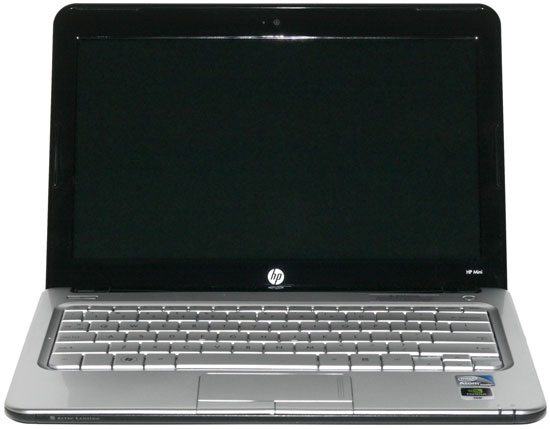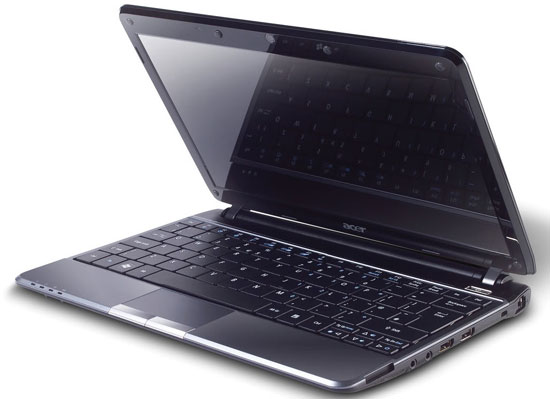Mobile Buyers' Guide, December 2009
by Jarred Walton on December 6, 2009 12:00 AM EST- Posted in
- Guides
NVIDIA ION
NVIDIA's ION platform uses the same N270/N280 Atom CPUs we've already discussed, but instead of the anemic GMA 950 Intel GPU you get an ION GPU - essentially the equivalent of the 9400M G. ION is significantly faster than GMA 950, but the Atom CPU is such a huge bottleneck that it really doesn't make for better gaming in the majority of titles. ION also helps with video decoding, and the combination of Atom and ION with the Flash 10.1 Beta allows for fullscreen HD video playback on YouTube, Hulu, and other similar sites. Without ION, you'll want to avoid HD Flash video on Atom netbooks.

The only real option for NVIDIA ION in this price bracket is the base model of the HP Mini 311. It's priced at exactly $400 (barring any holiday sales), and it comes with the bare minimum of amenities. You do get an HDMI port and an 11.6" 1366x768 LCD, but you only get 1GB RAM and an N270 CPU. HP's 311 integrates the 1GB of RAM on the motherboard, though, so you can easily upgrade the RAM on your own after the fact. The other ION netbooks are the Lenovo IdeaPad S12, which starts at around $430 with 1GB RAM and XP or $550 with 2GB and Windows 7; meanwhile, the Samsung N510 doesn't have an inexpensive option, going for 2GB and Windows 7 for closer to $600. In short, all of the ION netbooks are in the next price bracket after we make a few upgrades.
Intel CULV Laptops
Atom has a reputation of "fast enough" performance with great battery life and a low cost. It provides all of that, sure, but the catch is you can get something much better from Intel if you look around. The Celeron SU2300 is a dual-core CPU based on the Core 2 architecture, with a 10W TDP. However, TDP isn't a real indication of power requirements, and in testing it appears most of the 10W CULV CPUs are able to match Atom CPUs (within a few hundred milliwatts) in low power states.
CULV laptops do cost more than Atom laptops, but if you're looking at an Atom-based laptop costing $400 or more, you'd be crazy not to take a closer look at the CULV options. Even the Celeron SU2300 (1.2GHz, 1MB shared cache) is more than a match for the fastest single-core Atom CPUs - in raw performance, it's about twice as fast. Dual-core Atom CPUs should match the slower CULV processors, but pricing is going to be a wash as well.

There are at present two CULV laptops that meet our $400 criterion: the Acer Aspire 1410 and the Gateway EC1435u. The differences between these two laptops are mostly cosmetic, so buy whichever you like. Similar to ION, you get an HDMI port, the CPU will provide substantially more performance, and the GMA 4500MHD graphics will help with video decoding (unlike the GMA 950). You also get two SO-DIMM slots and a standard 2GB RAM (but it's 2x1GB so you'll have to ditch the SO-DIMMs if you want to upgrade to 4GB). Battery life is quite similar to what we've measured with Atom netbooks, with over 7 hours out of a 53Wh battery.
If it weren't for the Celeron SU2300 laptops, NVIDIA's ION would be a lot more attractive. That said, Flash 10.1 still doesn't decode all HD videos without a few stutters on CULV + GMA 4500MHD; 720p is usually fine, but higher bitrate videos and 1080p stutter. It's very likely an issue with the Intel drivers and the Flash 10.1 beta, though, as DXVA allows flawless 1080p x264 playback on these systems. Flash 10.1 also appears to have some image quality issues right now, so we're waiting for the final release to see how things pan out.
Other Inexpensive Options
We'll mention these last, but you can often find sales and used laptops for under $400. As one example, the Gateway NV52 we reviewed a few months ago, originally priced at $500, has been on sale for $400 several times during the past few weeks. If you value raw performance over battery life, the dual-core AMD laptops with HD 3200 graphics are worth a look, especially if you can find them for $400.
Our opinion on used laptops isn't nearly so positive. Unless you know the seller personally, buying used represents a risk, and buying used from an online auction site like eBay could come back to haunt you. Assuming all goes well, you can get a 2-3 year old laptop offering better performance than most new $400 laptops, but it will have (substantially) worse battery life. You might also find that the battery has gone through enough cycles that it needs replacing, which could end up being another $100 cost. We're not going to say you should never buy used laptops, but we definitely recommend caution. As the saying goes: if a deal seems too good to be true, it probably is.










49 Comments
View All Comments
JarredWalton - Monday, December 7, 2009 - link
I've placed an order... I'll do a review if they work well.yacoub - Sunday, December 6, 2009 - link
http://i.i.com.com/cnwk.1d/i/bto/20091118/by-manf....">http://i.i.com.com/cnwk.1d/i/bto/20091118/by-manf....I can't find the initial article anymore but this just came out a couple weeks ago.
http://news.cnet.com/8301-17938_105-10400447-1.htm...">http://news.cnet.com/8301-17938_105-10400447-1.htm...
HP had the most quality issues, Asus the least.
Blahman - Sunday, December 6, 2009 - link
If you thought the UL80Vt was good, check out its newer slimmer brother: the UL30Vt. It shares all the same specs, but better build quality and all packed into a thinner, lighter chassis.It's available from Amazon for $800. The reviews so far are very positive.
http://www.amazon.com/UL30Vt-X1-13-3-Inch-Laptop-W...">http://www.amazon.com/UL30Vt-X1-13-3-In...ctronics...
trickdaddy111m - Tuesday, December 8, 2009 - link
The UL30Vt does look very nice, but it lacks discrete graphics and the Turbo function of the UL80Vt. So, "same specs" is not accurate.KikassAssassin - Wednesday, December 9, 2009 - link
The UL30Vt has turbo and the discrete graphics. The specs are exactly the same as the UL80Vt except it has a 1" smaller screen, no optical drive, and a slightly smaller battery.You're probably looking at the UL30A.
KikassAssassin - Sunday, December 6, 2009 - link
The UL30Vt looks like a really nice alternative if you want something lighter than the UL80Vt and you don't need an optical drive. Unfortunately, the UL30Vt on Amazon is the X1 model that only has a 4400 mAh battery, compared to the UL80Vt-A1's 5600 mAh battery, so it'll only have about 80% of the battery life. The battery life should still be excellent, just not quite as amazing as the UL80Vt'stechwriters4breakfast - Sunday, December 6, 2009 - link
atom 2arrandale
bsoft16384 - Sunday, December 6, 2009 - link
I just want to give another shout out for the Acer 1410. This is an absolutely fantastic notebook for $400.I have the single-core version (Core 2 Solo SU3500, 1.4GHz, 3M cache) so it's somewhat faster on single-threaded code but slower on multi-threaded code than the Celeron SU2300 (1.2GHz, 1M cache). That said, I have no performance complaints about the laptop.
GPU performance is, as you would expect, pretty bad. But it's still dramatically ahead of a GMA950-based netbook (around 5X by my estimations), which makes it fine for playing older titles like Warcraft III, CS 1.6, UT classic or 2004, Quake 3 / OpenArena, Half-Life.
Even WoW runs "OK" on the Acer 1410, as long as you're willing to deal with ~20-30 FPS and a slideshow in Dalaran. But you *can* run it, and it's fine for doing dailies or checking the AH. I have my desktop if I want to play for real.
The keyboard is excellent, except for the page up/down buttons (which are annoyingly above the arrow keys) and home/end (combined with page up / down). Other than those annoyances, the keyboard is full-sized and has the layout that you would expect.
The screen is decently bright; contrast is "OK" but not great, and the viewing angle is lame (but so are most laptops). It's easily better than my ThinkPad T61.
There are some surprises port-wise: the 1410 has HDMI (with 8-channel LPCM audio) and the audio-out port does SPDIF/TOSLINK (with a 3.5mm to TOSLINK adapter), neither of which are common on a $400 laptop.
The WiFi is Intel 5100 802.11n, which is also nice. Ethernet is Atheros, audio is Realtek.
As you would expect with an ULV notebook, the 1410 doesn't really ever get hot, even at 100% CPU / GPU. It's not particularly noisy either, unless you have a defective fan (as my first one from Amazon did).
The 1410 takes forever to charge from empty (2.5 hours if off, 3-4 if on). That's because it uses the same 30W power supply as the Aspire One. On the other hand, the power adapter is very small and decently cheap, both of which are pluses.
Battery life is 5-6 hours, depending on how hard you push the machine. At idle, at minimum brightness, Windows reports over 12 hours, but you can't achieve this in practice. With light web browsing and Flashblock, expect 6+ hours.
The touchpad is Synaptics, and does multi-touch.
This system is the smallest, lightest system that I would consider a 'notebook' rather than a 'netbook'. I considered the HP Mini 311, but it maxes out at 3GB and doesn't support x86-64 or virtualization, plus the Core 2 Solo beats the pants off of the Atom. NVIDIA ION isn't really a whole lot better than the GMA X4500MHD, because the Atom CPU prevents you from playing any modern games anyway and the GMA X4500 does fine for Windows Aero and HD video acceleration.
Two years ago the Aspire 1410 would have cost $2000 and would be called an 'ultralight'. Today it's $400.
Keeir - Wednesday, December 9, 2009 - link
Don't forget its slightly more expensive brotherTimeline 1810T-8
Core 2 Duo (SU7300), 4 Gigs of Ram, Bluetooth, Larger HD, same wieght and battery
Picked mine up for <600 from Amazon (though I see they have ballons to close to 700)
notanakin - Monday, December 7, 2009 - link
Unfortunately this guide came out just a few days too late, but fortunately I'd settled on the Acer 1410 (SU2300) and it's a nice little machine. Certainly fast enough for simple tasks and for my old eyes the screen size is better than the 10.1 inchers.Here's a very useful link to a table of laptops/CPUs/Screen size prepared for the recent PC Show in Singapore where I bought the laptop. Great for doing some quick comparisons.
(Prices are in Singapore $ - about US$1=S$1.4, so the prices are a bit more expensive than in the USA, but they give some discounts off the published price and throw in stuff - I got an external DVD-writer plus a few smaller things with the Acer.)
But how I HATE the glossy screen. Are they cheaper than matte screens or what? I'd gladly pay US$50 more for a matte screen.